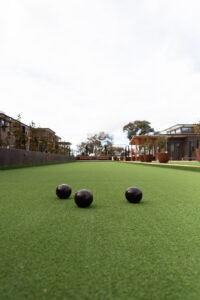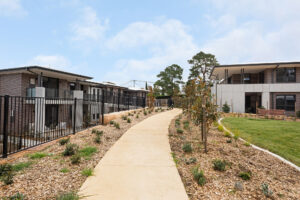Retirement and Aging environments have evolved significantly from older nursing home-style facilities to more engaging environments.
They are no more seen as a cause of isolation and anguish but are developed as thriving communities with the capability to accommodate the changing requirements of the user.
What was once special considerations are now commonplace design provisions including facilitating aging in place, incorporation of future technological advancements, and inclusive spaces for the diverse cultures and communities residing in Australia.
We have started seeing some distinct trends gaining immense popularity due to the flexibility they offer as a result. Vertical Villages, Integrated Developments, and the recently evolving Hybrid Care offerings are some of the growing trends we are seeing in the care space.
Integrated Developments
Spearheaded by the baby-boomer market, contemporary integrated villages are being designed and marketed around the provision of innovative resort-style resident services and facilities with a range of lifestyle options. They offer increasingly sophisticated allied health and wellness, generous hotel-like communal and reception spaces, and beautifully landscaped gardens together with some spaces + facilities which can be shared with the larger community such as libraries, childcare, and public piazzas for the community to gather and interact.
Stanton Dahl aims to take a balanced view when engaged in the front-end design process, to ensure the briefing and stakeholder review processes deliver a village masterplan with practical integration of these facilities, but also with serious consideration for the ongoing cost of maintaining and managing them.
Our approach is always to consider people first – obviously our client’s objectives, but also the residents and occupants of the development. Can that particular market support the hydrotherapy pool, the extensive landscaping, and water features; or should that budget be directed elsewhere? High purchase costs and expensive ongoing fees are bigger concerns in more cost-sensitive locations, and all this has to be factored into the business case and early conceptual planning of the facility.
The increased popularity of this type of facility talks to community preference for a lifestyle-driven experience through retirement, and the desire to be able to age in place in a dignified manner – within your own community as much as your own home.
There are many models in development pursuing this sort of innovation in specialist residential typologies, and we believe this trend will continue. Service providers who develop and operate their own facilities drive many of these innovations which are the result of extensive research into their models of care. One such area which is increasingly prevalent is the rise of vertical villages.
Vertical Villages
Vertical villages are essentially integrated facilities incorporating aged care and retirement living with the associated facilities – just in buildings with multiple stories. Vertical villages are typically located in more densely built-up urban areas around capital cities, where land costs are much higher. The increased desire to live closer to urban centres is clearly not just about living closer to work; but having access to entertainment, cultural facilities, and transportation.
These sorts of villages can provide much needed aged care accommodation in areas that are undergoing significant densification and gentrification. In contrast to older people moving further away to seek care, and therefore becoming isolated from their communities, family, and friends.
There are some good examples of recently completed developments that are pursuing innovation in specialist integrated facilities – and we believe this trend will continue – particularly for urban sites where vertical villages are the most appropriate and competitive way of delivering a product to the market.
As care models evolve, and the industry develops accommodation products further aligned to their customers’ requirements, subtle variations are also beginning to emerge. Service providers who develop and operate their own facilities drive many of these innovations which are the result of extensive research into their models of care.
Together with carefully considered space planning of the key components of the building including the RACF, ILU’s, ground floor common areas, and basement areas, Stanton Dahl places a strong emphasis on the quality of external open space in vertical village design. This is critical for older and less mobile residents, to enable easy and hassle-free access to open space and fresh air.
Consolidated tower and podium building forms provide excellent opportunities to create safe quality outdoor spaces to provide resident amenity. Ground-level landscaped spaces offer opportunities for family and visitors to get together for a walk or a picnic – close to cafés and BBQ terraces and reception areas. Podium level terraces and rooftop areas can also provide high quality open or alfresco spaces for residents to enjoy, but with a bit more privacy. Lastly, private balcony spaces are a great opportunity to provide a generous, comfortable, accessible, and useable private open space, vastly improving quality of life and well-being in residents of all ages and levels of mobility.
In NSW, there are incentives to specialist developers seeking to provide vertical village type accommodation on a site; to allow the cost to yield benefits to be comparable to other types of residential or commercial development.
The Aged care staff at Stanton Dahl have successfully integrated the applicable incentives for the benefit of our clients in past projects and are readily available to discuss the possibility of exploring further benefits that can be availed from a Vertical Village response to a product offering.
Hybrid Product offerings
The Royal Commission inquiry followed by the bushfires, the long-running drought, and then the Covid-19 has all had a severe impact on the sales of Retirement and Aging places. Bucking that trend, some providers have reported soaring sales figures and unprecedented demand. Their product was uniquely placed to address one of the most highly distressing aspects of aging – physical and social displacement.
These types of care offerings combine the freedom of Retirement living with the care and attention delivered in a RACF. Best of both worlds! We refer to this as a Hybrid care product as it affords the resident much-valued freedom of movement and the ability to make the social connections that become valuable as they age in place.
It is well established that disconnection with their familiar social setting is a prime cause of aggravated mental degeneration in elderly people. Having the ability to see the familiar faces of the local butcher, baker, or newspaper agent have proven to act as cues for the memory which enhances independence, which in turn becomes a vital social requirement with age.
Designing a space to allow for this to occur brings about its own set of exciting opportunities as well as challenges especially in regard to code compliances due to the current absence of an NCC building Class which could readily be applied to such a facility. We are finding it prudent to apply the more stringent of the two-building class requirements while utilising some benefits from the less onerous Class without compromising on the health and safety aspects in any form or manner.
With this concept being fairly unexplored, every project would require an in-depth assessment from the Certification point of view.
The first of the flagship projects for any provider would also involve scrutiny of the existing operational model and an overhaul of the existing protocols and systems to allow for a combination product to be successful. In-depth study and exploration of the new directions in the early conceptual phase can clearly set up a basis for innovation and strategic thinking to explore fresh ways in which integration can occur.
We have explored several hybrid design concepts in this regard, and are excited about the possibilities that these can bring to aged care environments.

